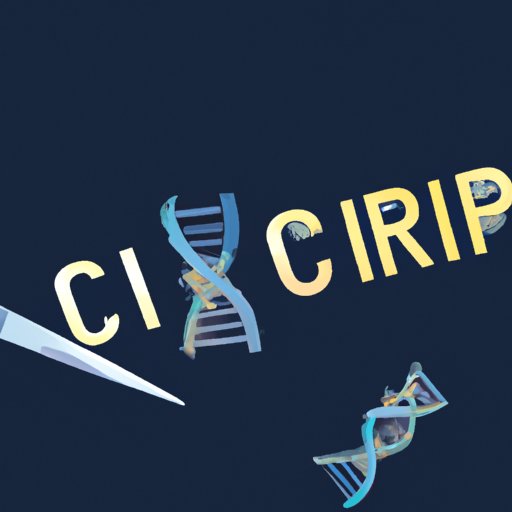Introduction
CRISPR (Clustered Regularly Interspaced Short Palindromic Repeats) technology is an innovative tool for gene editing that has revolutionized the field of biotechnology. It has the potential to be used in a variety of applications, including medical research, agriculture, and even personalized medicine, but it also raises important ethical questions. This article will explore what CRISPR is, how it works, its current uses and potential future applications, as well as the ethical implications of using this technology.
Explaining the Basics of CRISPR Technology
At its core, CRISPR technology is a type of gene-editing tool that allows scientists to make precise changes to the DNA of organisms. To do this, it relies on a combination of two components: a “guide” molecule and an enzyme. The guide molecule, which is typically a strand of RNA, binds to a specific section of the DNA and directs the enzyme to that location. The enzyme then cuts the DNA at that point, allowing the scientist to insert or delete genetic material. This process can be used to modify existing genes or create entirely new ones.
The major benefit of CRISPR technology is its precision. Unlike previous gene-editing tools, such as zinc finger nucleases (ZFNs) and transcription activator-like effector nucleases (TALENs), CRISPR is much more accurate and efficient. It can target multiple genes at once and make precise changes without disrupting the surrounding DNA. This makes it possible to create highly customized organisms with specific traits.

How CRISPR is Being Used in Medical Research
CRISPR technology is being used in a variety of medical research applications. For example, it can be used to study the effects of genetic mutations by creating animal models with specific genetic defects. It can also be used to develop treatments for genetic diseases, such as cystic fibrosis and Huntington’s disease. Additionally, researchers have used CRISPR to create cancer cell lines that better mimic the behavior of tumors in humans.
In addition to these applications, researchers are exploring the potential of using CRISPR to edit the human genome. While this is still in the early stages of development, some studies have already shown promise. For instance, a recent study found that CRISPR could be used to correct a genetic mutation that causes a heart condition called hypertrophic cardiomyopathy. This study showed that it is possible to use CRISPR to make precise changes to the human genome, which could lead to the development of treatments for a wide range of genetic diseases.

Examining the Ethical Implications of CRISPR
The use of CRISPR technology raises important ethical questions. On one hand, it has the potential to revolutionize medical research and create treatments for genetic diseases. On the other hand, it could be misused to create “designer babies” or to manipulate the human genome in dangerous ways. It is important that these issues are addressed before any further progress is made.
One potential solution is to establish strict regulations on the use of CRISPR technology. This would ensure that it is only used for legitimate medical purposes, and that any potential risks are minimized. Additionally, further research is needed to understand the long-term effects of using CRISPR to edit the human genome. Only then can we make informed decisions about the potential benefits and risks of using this technology.
A History of CRISPR’s Development and Evolution
The story of CRISPR technology begins in 1987, when Japanese researcher Yoshizumi Ishino first identified the CRISPR/Cas system in bacteria. Since then, a number of researchers have contributed to the development of CRISPR technology, including Jennifer Doudna, Emmanuelle Charpentier, Feng Zhang, and George Church. These scientists have worked together to refine the technology and make it more precise and efficient.
Over the past decade, CRISPR technology has experienced rapid growth and development. In 2011, Doudna and Charpentier published their landmark paper on CRISPR, which laid the groundwork for the technology’s current uses. Since then, CRISPR has become a widely used tool in biotechnology, and its potential applications continue to expand.

The Current State of CRISPR Technology in the World
CRISPR technology is currently being used in a variety of fields, including medical research, agriculture, and even personalized medicine. In medical research, it is being used to study genetic diseases and develop treatments. In agriculture, it is being used to create crops with improved yields and resistance to pests and diseases. And in personalized medicine, it is being used to create tailored treatments for individual patients.
Despite its many potential uses, there are still challenges facing CRISPR technology. For instance, there is still a lack of understanding about the long-term effects of using CRISPR to edit the human genome. Additionally, there are ethical concerns about the misuse of this technology. As such, it is important that the scientific community continues to work together to address these issues.
Conclusion
CRISPR technology is a revolutionary tool for gene editing that has the potential to revolutionize medical research and create treatments for a wide range of genetic diseases. However, it also raises important ethical questions that must be addressed before it can be used safely and responsibly. By studying its history, exploring its current uses, and examining the ethical implications of using it, we can gain a better understanding of this powerful technology and its potential impact on the world.
(Note: Is this article not meeting your expectations? Do you have knowledge or insights to share? Unlock new opportunities and expand your reach by joining our authors team. Click Registration to join us and share your expertise with our readers.)
